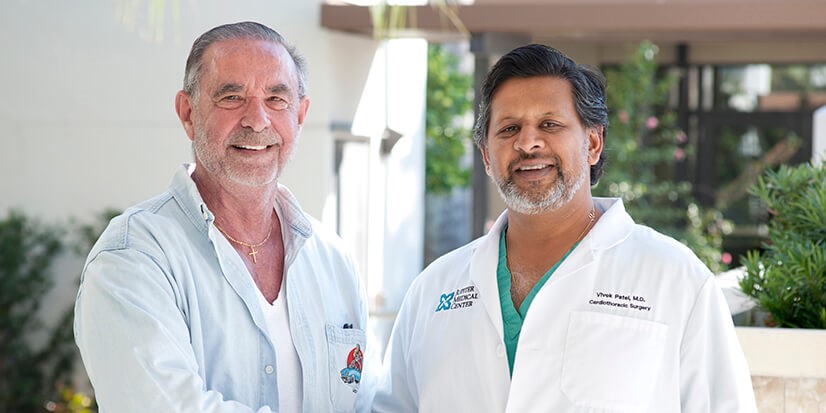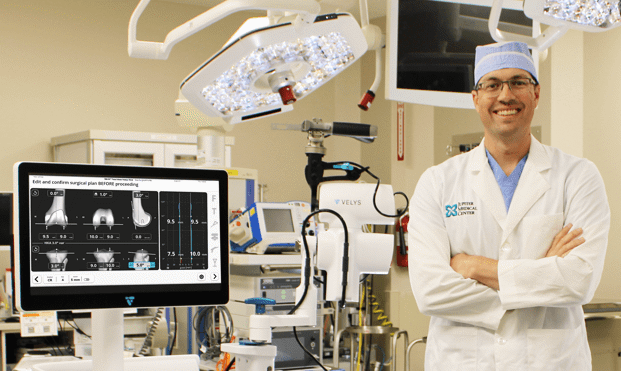Gerry's Story
- Author: Gerry Hermann
- Category: Robotic Heart Surgery


“ I kept telling myself, this device can’t be this good, and if it is this good, how far away am I going to have to travel to get this treatment? I was thinking Miami? New York? Boston? San Francisco? And yet I ended up right here at Jupiter Medical Center with this amazing team.”
Reversing Heart Failure with Barostim™ Technology: “This Implant Has Saved My Life”
Dr. Vivek Patel, a cardiothoracic surgeon at Jupiter Medical, has a description for a new high-tech, implantable cardiac device designed specifically for patients with heart failure: “a life changer.”
Jupiter resident Gerald Hermann, 74, a lawyer for more than 40 years and an extreme body builder, agrees wholeheartedly.
“It’s impossible to explain to someone who hasn’t had congestive heart failure what it’s like,” says Hermann, an active attorney who has lived with heart disease for more than 25 years. “It’s not just the shortness of breath or lack of energy. It’s generally feeling awful and having no quality of life. But this implant has changed my life.”
They’re talking about Barostim™ technology, a new cardiac device that Dr. Patel implanted in Hermann in early November.
An alternative to medications
Typically, patients with heart failure are treated with various medications designed to improve heart function and increase blood flow, reduce shortness of breath and control fluid build-up in the body, says Dr. Patel, a board-certified and fellowship-trained cardiothoracic surgeon at Jupiter’s Robson Heart & Vascular Institute. But some patients never respond to medications and must accept a lifestyle defined by limited activity.
“For some reason, the heart muscle is weakened in patients with heart failure, and that leads to difficulty breathing, exercising and an overall decrease in stamina and ability to enjoy things in life,” Dr. Patel explains.
“Baroreflex activation therapy” is how CVRx, the Minnesota healthcare technology company that invented Barostim, describes the implant’s goal. It addresses congestive heart failure and a low or reduced ability of the heart to pump oxygenated blood to the rest of the body.
“The Barostim device basically tricks your body into thinking that the arteries are not so tight,” says Dr. Patel. “Its presence loosens the arteries in the body, allows blood to flow more freely and eases patients’ symptoms.”
How Barostim works
During an outpatient procedure, the device is implanted into a patient’s neck on the carotid artery. In a healthy body, specialized pressure sensors called baroreceptors on the carotid artery send information to the brain to regulate blood volume and blood pressure. But in patients with heart failure, those sensors underperform, causing blood vessels to tighten when they should allow blood to flow freely. Barostim’s battery-generated electrical impulses tell the brain that blood volume and pressure have returned to normal, allowing the patient’s blood to flow freely again.
In early November, Herrmann was Dr. Patel’s first Barostim patient in an outpatient procedure that kept him at the hospital for only about four hours. Recovery typically stretches 4-5 days before a return to normal activities.
“Within 2 hours of coming out of anesthesia, I felt 10 years younger,” Hermann says of his ongoing recovery. “Within just a few weeks, I’ve gotten 30%-40% of my energy back, and I can’t wait until they dial up the device at my next visit.”
Hermann has already resumed his body-building routine (“I’m in better shape than most of the 30-year-old guys at my gym….I outlift them, out-endurance them…they can’t keep up”) and he looks forward to continued improvement as the implant is adjusted and regulated over the coming months to match his body’s cardiac capacity. With prior authorization, the device is covered by many insurance carriers and Medicare.
Who is the ideal candidate?
Patients who should be evaluated for Barostim include those who have lived with and been treated for heart failure for a long time without results, says Dr. Patel. Most have taken heart medications but still experience low energy or struggle to catch their breath with even minimal exertion.
Herrman says he learned about Barostim as part of his legal research for healthcare clients. A friend connected him to his Jupiter team, Dr. Patel and interventional cardiologist Dr. Michael Sabah.
Says Hermann: “I kept telling myself, this device can’t be this good, and if it is this good, how far away am I going to have to travel to get this treatment? I was thinking Miami? New York? Boston? San Francisco? And yet I ended up right here at Jupiter Medical Center with this amazing team.”
For information about cardiac care, contact the Robson Heart & Vascular Institute at Jupiter Medical Center at 561-263-3767.
